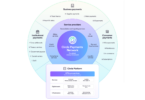In China, new experiments offer shoppers a single “aggregate” QR code that works for the digital yuan as well as other digital payment apps Alipay, WeChat Pay, and UnionPay QuickPass. An unusually frank press report acknowledges the low usage of the central bank digital currency (CBDC). Most usage is for government use cases or ‘red envelope’ money giveaways.
This slow uptake is despite an ever increasing number of scenarios where consumers can use the digital RMB. Part of the problem is that people don’t always know where they can pay with the CBDC. If all retail outlets start using the aggregate QR code, that could quickly expand the options for the digital renminbi.
Given the dominance of Alipay and WeChat Pay in mobile payments, UnionPay’s QuickPass initially encountered the same challenge.
In 2018, a new rule required Alipay and WeChat Pay to clear barcode payments through UnionPay, China’s (state-owned) version of Visa. Subsequently, in 2021 the three organizations made their QR codes interoperable.
We’re guessing that when someone scans an aggregate QR code, it triggers logic to convert the QR format. In other words, if they scan with Alipay, the Alipay app converts the content of the aggregate QR code into something digestible by Alipay. And likewise for each of the other three apps.
However, many users are quite happy using WeChat Pay or Alipay and don’t have an incentive to use the digital yuan. Merchants are incentivized because with the CBDC they don’t have to pay the Alipay or WeChat Pay merchant fees. However, those fees can be pretty low, starting at 0.55%. So the incentive for merchants is also not significant.
As we’ve previously reported, we can expect the statistics for payment volumes to rise significantly as the digital yuan is increasingly used for business and financial applications.






